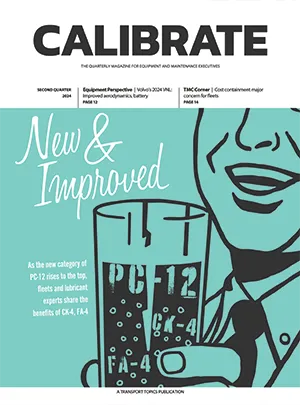Features Editor
Work Continues on Establishing PC-12 Oil Category

[Find the latest in equipment & maintenance: Explore this quarter's issue of Calibrate]
Since March 2021, the process of developing the heavy-duty engine oil category known as Proposed Category-12 (or PC-12) has been slow and steady, as it was advertised. From the initial suggestion of the Engine Manufacturers Association to the American Petroleum Institute to the establishment of the New Category Development Team, the tedious process is now past its third year and the new oil is scheduled to be formally introduced in 2027. PC-12 is the 12th industry request process of diesel engine oils.
Although the team is making progress in the developmental stage of PC-12, which will replace the current API CK-4 and FA-4 engine oils, there are still hurdles ahead of the finish line, said Karin Haumann, OEM technical manager for Shell Global Solutions and chairwoman of API’s new category development team.
“The biggest challenge is maintaining backward compatibility while at the same time being able to take the engine oil technology to the next level in terms of efficiency and helping the OEMs,” she said. “But you still have to, for instance, be able to handle all of this generation of the older engines at the same time, and newer and wider range of heavy-duty equipment from lawn mowers to mining equipment and everything in between. It’s getting everybody’s objectives in a single category.”
As work continues on the new oil category, the industry at large has been preparing for the creation of PC-12 while working the ongoing adoption challenges with the current engine oils. Those steps were discussed during a technical session at the 2024 Technology Maintenance Council Annual Meeting and Transportation Technology Exhibition in New Orleans in March. At that session, Greg Matheson, commercial lubricants product manager for Lubrizol Corp. explained the benefits of FA-4 engine oils, stating that through the years, lubricants have been performing in more High Temperature High Shear (HTHS) environments. HTHS measures oil flow resistance, simulating the narrow tolerances between the moving parts (camshaft, piston, bearing, etc.) in a hot engine.
More Q2 Calibrate

►Work Continues on Establishing PC-12 Oil Category
►Freeze: Balancing Out the Future
►Fleet Concerns Remain Dynamic for 2024, TMC Data Says
►Baxter: Volvo’s 2024 VNL: Surprising Electrical, Mechanical Changes
Explore the Issue!
“You think about today’s engines, they are running at the hottest operating temperatures we’ve ever seen. There is much tighter tolerance, and less room for the oil to flow,” he explained, adding that the HTHS number indicates how well that oil flows through that engine. The lower the number of HTHS, the more potential efficiency it will bring, because it will cause less energy to flow through that engine. “Lower is a good thing because it brings more benefits to the engine,” Matheson said.
Backed by a 2016 North American Council for Freight Efficiency confidence report study, Matheson stated the expected savings when moving to lower viscosity lubricants is significant and can be implemented quickly with minimal upfront investment. Fleets experienced fuel savings from 0.8% to 1.5% by switching to CK-4, and an additional 0.4-0.7% when switching to FA-4.
In addition, in a case study presented by Bhaskar Prabhakar, commercial vehicles lubricants product line manager with Exxon Mobil, FA-4 oils are still seeing limited adoption. Prabhakar cited a general lack of awareness for the low rates. However, he noted, progressive fleets with support from lubrications engineers tested FA-4 engine oils and successfully converted fleets, producing a potential 1-2% savings in fuel efficiency per truck.
“You have to remember that there’s no compromise in wear protection,” Prabhakar said. “The gains are never realized overnight.”

Results in oil change intervals have proven to increase maintenance efficiency. (Shell Rotella via Instagram)
He also presented an example of a large transportation company who had used CK-4 engine oils with a drain interval of 50,000 miles. Once the fleet switched to FA-4 and a new interval of 70,000 miles, the company experienced 475 hours saved from oil changes alone. Also, the fleet’s lower lube and fuel use dropped nearly 230,000 gallons, saving them $700,000 per year.
“That’s a 3% fuel economy benefit,” Prabhakar summarized. “That’s a huge difference.”

Prabhakar
Looking forward to the PC-12 category, he concluded the change will bring greater emphasis on lower viscosity engine oils to improve fuel economy. “A shift in mindset from everyone, from consumers to OEMs, will drive greater adoption of FA-4 engine oils,” he said. “We anticipate more fleets will convert to ‘F’ category oils between now and 2027 and beyond.”
Ryan Denton, corporate chemical technology manager for Cummins, noted there are practical adoption challenges for fleets concerning FA-4 such as using third-party maintenance that offers less control on oil use than in-house shops, risk perception or lack of compatibility. However, Denton offered that as more heavy-duty fleets investigate FA-4, adoption will increase.
He also cited that PC-12 initiatives include optimizing chemical limits for aftermarket/emissions requirements and achieving lower viscosity grades, like XW-20 oils, among OEMs.
“As carbon emissions requirements become more stringent over time, some OEMs have requested to have XW-20 oils into the market,” he said. “XW-20 oils typically have thinner oil films and lower HTHS viscosity than API oils commercially in the market today.”
Denton compared this situation to the previous oil category designation process of FA-4.
“Let’s rewind 10 years ... we said the same thing for FA-4. When we were in 2014, planning for 2017, we said, ‘Hey, gas emissions are coming. We need technology available to us to reduce fuel economy,’ ” he said. “And here we are, seven years later, and FA-4 hasn’t penetrated the market yet. You can expect the same thing here.”
Denton said that oils like FA-4 will be pushed by OEMs, as they are desperately needed for the commercial market.

Brent Hilton with Maverick Transportation speaks at the S.6 Study group meeting at 2024 TMC. (John Sommers II for Transport Topics)
Brent Hilton, director of maintenance of Maverick Transportation, said that CK-4 oils fit his fleet’s needs when bringing trucks back to the shop for service intervals. Hilton explained that he is a believer in continuous evaluation of oil sampling, as he described that his cycle is conducted every 35,000 miles, and every 300,000 miles on drivetrain. He also stressed that a fleet shop should have a designated person to monitor those samples.
“I highly recommend that for any fleet. It takes a long time to know your oil samples and understand what they are telling you,” Hilton said. “If you are not aware (of specific problems), you’re going to lose efficiency.”
Maverick USA ranks No. 79 on the Transport Topics Top 100 list of the largest for-hire carriers in North America.
He also recommended that fleet managers know their original equipment limit on all measured contents of an oil sample and act on samples that have issues.
“It’s no different than going to your doctor’s office for a blood test,” he maintained.
As for testing for fuel economy, Hilton recommended the SAE Type 4 fuel economy testing to determine exact results of fuel usage when comparing products. He also explained that his team performs oil drains at intervals of 70,000 miles, which saves costs for the fleet, and the increased uptime keeps the driver satisfied.
“We went from two oil changes a year to one-and-a-half and are looking to go to one a year or every 100,000 miles, which would eliminate half an oil change a year,” Hilton said. “So, our driver is on the road making money for longer periods. You keep them happy.”
Waleed Salama, reliability engineer, powertrain service engineering for Daimler Truck North America, said that despite any manager’s preference toward CK-4 or FA-4, they should focus on the benefits to their fleet.
“At the end of the day, you have to do a proper cost analysis to see if they are a fit for your fleet,” he said. “You have to do the math and if you find that it’s not a good fit for your fleet, it just is not. You must be practical.”
Want more news? Listen to today's daily briefing below or go here for more info:




